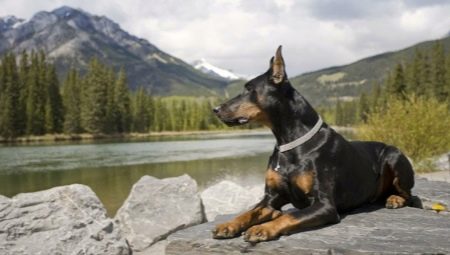Doberman is an animal with high intelligence and noble appearance. In many films, the Doberman is presented as a furious defender with an aggressive character. But this dog is not only an alert guard and guard, but an amazing companion dog, a devoted member of the family.
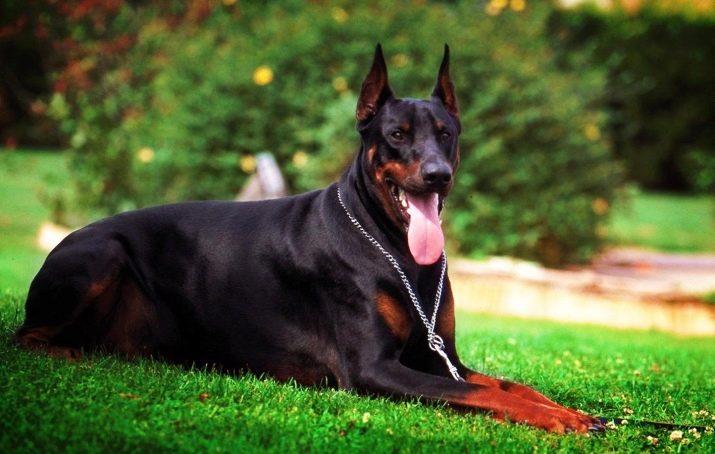
History of occurrence
The creator of the breed is Frederick Louis Doberman, who lived in 1834-1894 in the German city of Apollon. Various sources mention that he changed various professions: tanner, mortgage worker, night watchman, tax collector. His work was not safe - a walk around the city with the money collected was associated with the risk of an attack by bandits, so Frideric thought that he needed a guard dog.
According to the creator of the breed, the dog should harmoniously combine such qualities as high intelligence, endurance, strength, courage, devotion. And also ideal for protection, that is, to have certain fighting qualities. The initiator of the breed, unfortunately, did not leave any entries, so a lot of information about the Doberman will remain a mystery. This creates certain difficulties for modern dog handlers, because the concept of dog breeding cannot be unambiguously traced.
In addition to hybrid dogs, the origins of this breed were short-haired pinscher, German shepherd, German pointer, Rottweiler, Manchester terrier, and greyhound. According to the Dog Magazine of 1910, the Doberman also has an admixture of the blood of the French Beauceron, with which he bears a resemblance.
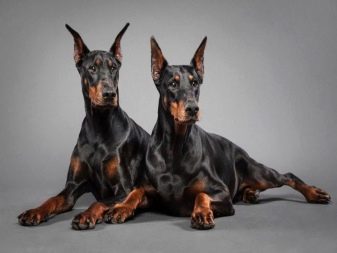
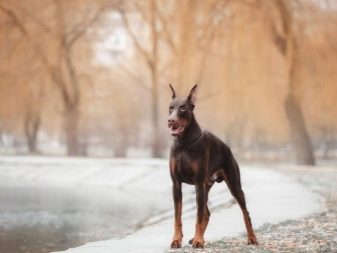
The pedigree of the modern Doberman begins with a dog named Earl Belling von Grunland (1899 year). It was only slightly different from the Rottweiler. From the very beginning of the creation of the breed, the main idea was the usability of the dog. German breeders continued the work of Doberman on the development of the breed. Their main goal was to form the character and functions of the dog, which he had to perform. Appearance was secondary. The choice of dogs for breeding lay only on the most daring, quick and smart individuals.
In 1899, the German Dobermann Pinscher Society was founded. Initially, the breed was called that way, but in the middle of the twentieth century the use of the second word was discontinued.
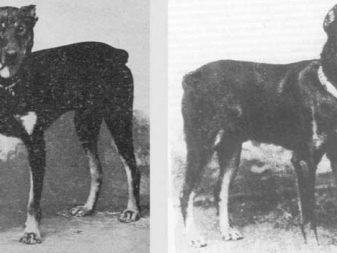
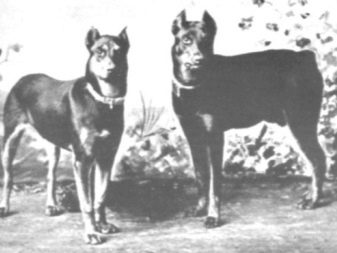
Due to his extraordinary courage, endurance and calm reaction to the shots, the Doberman was evaluated as a police and military dog. He proved himself during both world wars.
During World War I, he was included in European military units as a service and medical dog. This fearless and trustworthy dog also attracted the attention of the US military.
During World War II, he served in the army on both continents. At that time, he also gained the notorious reputation for being a service dog in concentration camps. During the war years, 45 thousand dogs served in the German army. They were used as couriers to transmit military reports, they often had to be under enemy fire. Also, dogs of this breed showed themselves as excellent bloodhounds: they could follow the trail for 4-5 days or even longer.
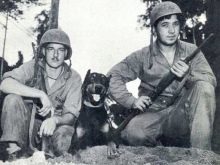


Breed description
According to the description of the standard, Dobermans are medium-sized dogs, muscular, athletically built, but not overweight. The top line is slightly sloping, the bottom is taut. The silhouette of the dog looks more square than elongated. The height at the withers is approximately equal to the length of the body.
Characteristic of the breed:
- Growth at the withers of males is 70 cm (± 2 cm), bitches - 66 cm (± 2 cm).
- Weight - males - 43 kg (± 2 kg), females - 33 kg (± 2 kg).
- The head is proportional to the body, wedge-shaped. The edge of the forehead is small but clearly marked.
- The ears are medium sized, set high. Can be docked. But not in all countries dogs with cropped ears are allowed to exhibit.
- The bite has a scissor shape.
- The eyes are oval, dark in color.
- The skin is intensely pigmented.
- Coat - short, hard, smooth, tight-fitting, without undercoat.
- The color is black, dark brown or gray.
- Tail high landing. It stops very short, only 2 vertebrae are visible. It is allowed to leave it in its natural form.
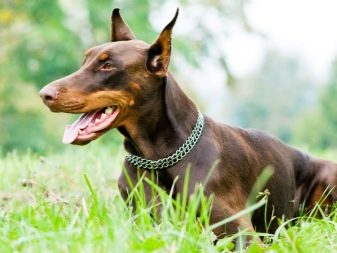
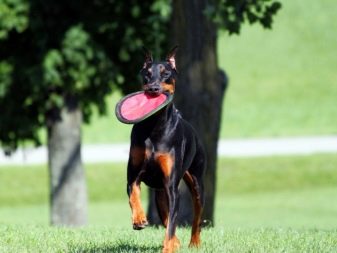
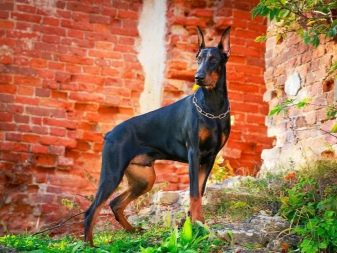
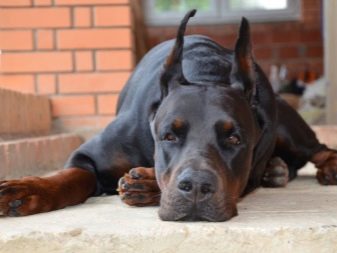
Disqualifying deficiencies:
- shyness, shyness, nervousness and excessive aggression;
- eyes yellow, blue or different colors;
- teeth are missing, the bite is not scissor;
- the coat is not short either with white spots.
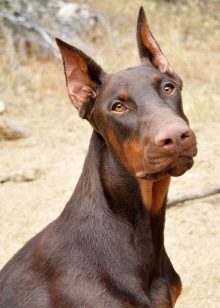
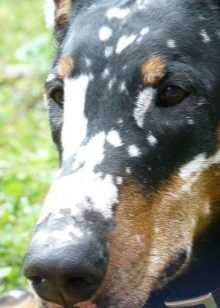

The average life expectancy of these dogs is 10-11 years. Doberman is considered a healthy dog. However, it is worth knowing what diseases it can still be susceptible to.
- Hip dysplasia. Before buying a puppy, you should ask the breeder to check his parents for dysplasia.
- Progressive retinal atrophy - gradual visual impairment. The disease is hereditary. In many countries, breeders are required to conduct puppy research - electroretinography.
- Von Willebrand disease is a hereditary pathology that impairs the ability of blood to clot.
- Hypothyroidism is a dysfunction of the thyroid gland, as a result of which the dog may suffer from epilepsy, alopecia, obesity, drowsiness and skin diseases.
- Wobbler syndrome is an ailment that occurs in puppies. Due to the rapid growth, the spinal cord can be squeezed in the cervical spine. As a result, the dog loses control of the hind limbs.The animal begins to limp.
- Cardiomyopathy is a myocardial disease in which irreversible changes in muscle fibers occur. Their shape, elasticity and contractility are changed so that the heart muscle loses its performance.
- Albinism is a genetic mutation. Dobermans-albinos have many different diseases, including photophobia.
- Narcolepsy - attacks of drowsiness.
- Disorders of the stomach.
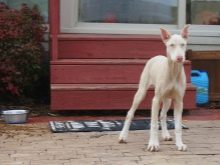
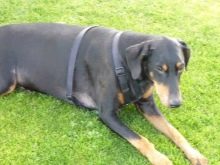
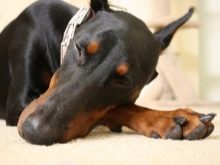
Proper diet, care and periodic consultations of the veterinarian will help to maintain the health and life of the pet.
What is the difference from a dwarf doberman?
The German pinscher (smooth-haired pinscher) appeared in the 1800s when he was closely associated with the standard schnauzer (rough pinscher).
The crossing of the German pinscher and the standard schnauzer was approved. The purpose of this was to update the gene pool of breeds and reduce the problems associated with the health of dogs.
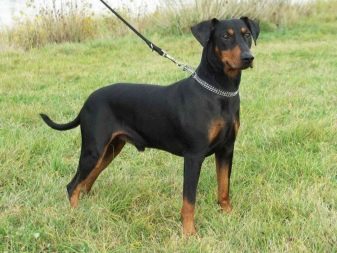

In the Doberman standard, the growth of males varies from 66 cm to 71 cm, and females - from 61 cm to 66 cm. Adult females can be the same size as males, but should not be taller than males. The mass of their body is 30-40 kg.
Dobermans have a short and smooth fur of black, dark brown, gray or fawn. This is a strong muscular animal.
Doberman has an almond-shaped eye shape. The nose is black for black dogs, brown for red, dark gray for gray and dark for fawn.
Dogs live on average 10-11 years. 3-8 puppies are born in the litter. Dobermans are smart, learn fast. They are more patient (than their mini-brothers) and are ready to do what is required of them.
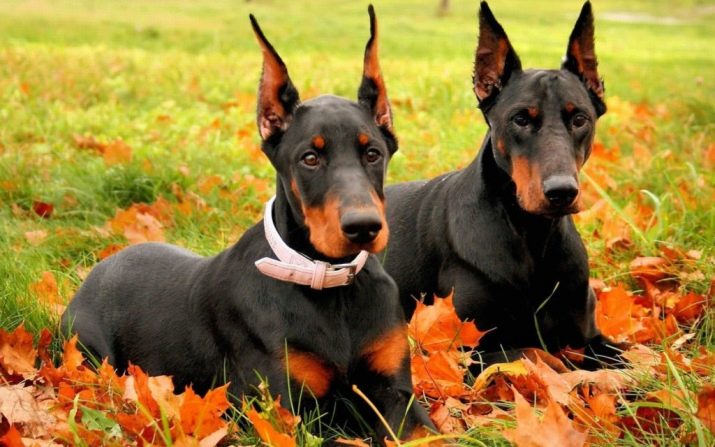
German pinscher with a height of 43 to 51 cm and a weight of about 5 kg. This is a medium-sized dog, has well-developed muscles. The hind limbs are shorter than the front. The coat is smooth, the color is black, brown. It may be a two-tone color. The eyes have an oval cut. All German pinschers have black eyes, black lips, black noses and black claws, regardless of the color of the fur. Their life expectancy is up to 15 years.
German pinschers at heart are terriers. They like to be fun, they are smart and learn fast. But there are also stubborn ones.

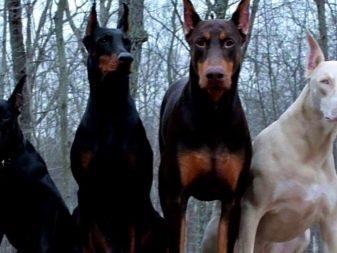
Dwarf pinschers are miniature copies of the famous Dobermans, but despite the obvious similarities, they are not related. These dogs are very funny and energetic. Like Dobermans, they are ideal companions for various games, long walks and travels.
The Mini Doberman is a friendly and at the same time fearless dog. She has an innate intellect, so she is very well trained and quickly learns new skills. Miniature sizes do not prevent her from being a great security guard and guard dog.
Karl Friedrich Louis Doberman was able to bring a dog that looks like a miniature pinscher, but more impressive in size.
Doberman is a very popular breed, but a miniature pincher outperforms it in that it can live even in the smallest city apartments. Interest in miniature species of dogs is growing every year, as well as the number of kennels growing them.
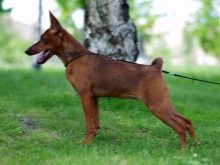
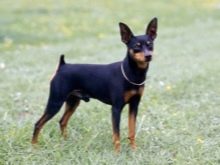
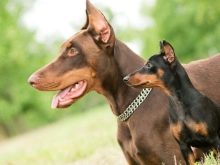
Nature and behavior
Doberman is a very intelligent and active dog, loyal and trustworthy. He will not hesitate to act when he discovers that his family is in danger. Despite the fact that he is an excellent defender, basically he does not show his aggressions for no reason.
Doberman loves all kinds of physical activity. He learns teams very quickly, but training should begin relatively early. During training, a high responsibility and firmness of the trainer is required.
An important feature of this breed is a high degree of sensitivity, constant vigilance and careful registration of everything that happens around. A strong bond with the owner and his family is very important for dogs of this breed. Both this question and the whole process of socialization, education, training of Dobermans require more diligence, time and attention than when training other dogs.
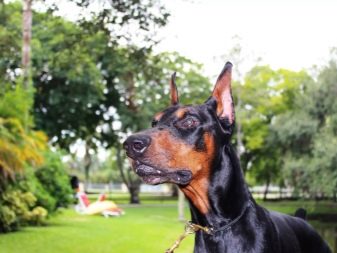

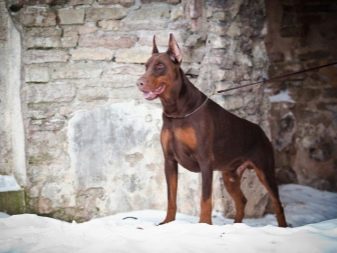
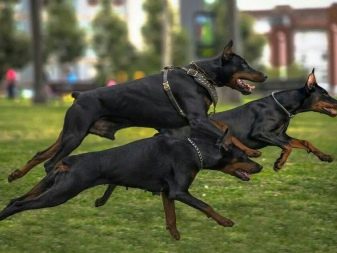
Unlimited affection for the owner, incorruptible nature of this dog exclude the possibility of transferring it to other hands. A faithful dog feels disappointed and deceived. This can lead to pathological behavior, mistrust and aggression.
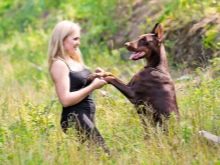
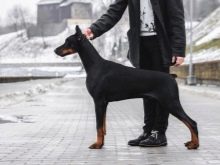
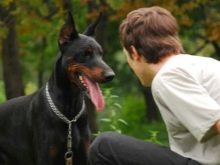
A psychologically healthy Doberman does not show a tendency to intentional aggression against people and animals. Various sources describe the case when a Doberman brought a herd of young striped boars to the village. Their mother was shot dead the day before during the hunt. Another time, the same dog was seen at the edge of the forest when she was playing with two young deer.
Conscientious breeders select calm and balanced dogs for breeding. But due to the popularity and mass character of this breed, there are cases of an unprofessional approach to breeding, so some individuals experience excessive aggression or cowardice - signs that are denied by the breed standard.
One of the main advantages of the breed is that Dobermans have high intelligence. This means that the dog is very susceptible to training, training and socialization.
The disadvantages of the breed include the fact that they can be potentially dangerous to people and animals around because of their impressive size, strength and aggression against strangers.
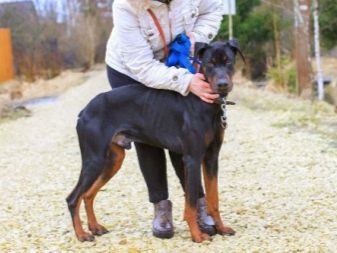
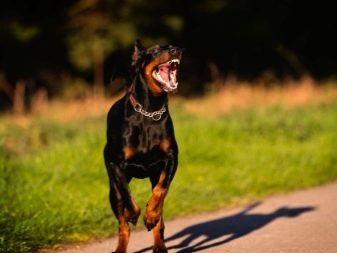
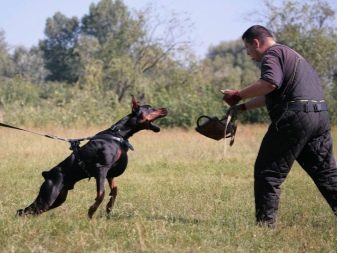
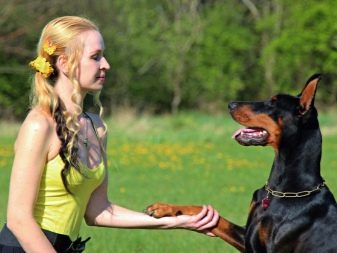
A well-bred Doberman is a great family dog. Provided that the puppy has been trained and socialized properly, the Doberman will be a reliable dog that will protect against danger if necessary. It is also important for children to learn the proper handling of this breed.
Doberman gets along well with other animals that are in the family. Well, if they were taken to the house at the same time. They can be aggressive towards unfamiliar dogs if they decide that they are at risk for their owner or family members.
Doberman is a protective and guard dog. He is confident and fearless, ideal for serving in the police or army. Nevertheless, their character is quite peaceful. With a man whom the dog trusts, he will behave very friendly.

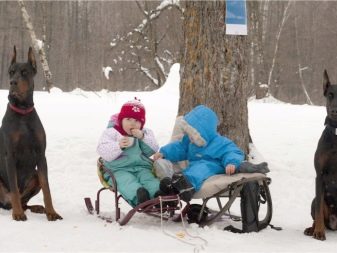
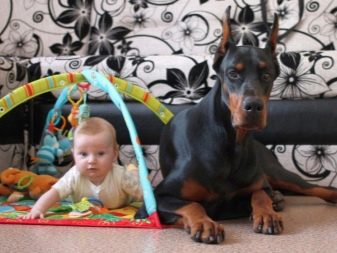
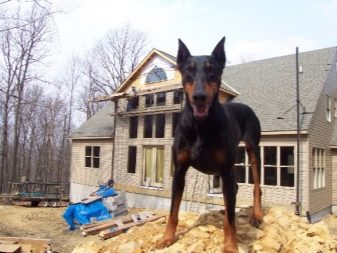
How to choose a puppy?
Representatives of the Doberman breed are strong, agile, persistent, graceful and loyal dogs of their owners. Doberman is a great small animal hunter, guard and warrior. But for many, he is primarily a faithful friend. A responsible approach is required to choose a puppy.
- First you need to decide for what purpose a puppy is acquired - participation in large exhibitions, for reliable protection or just as a true friend.
- The puppy's gender is chosen at its discretion. If the future owner wants to see a gentle and attentive dog in his house, it is worth choosing a female. If you dream of a tall, noble, amazing companion, you should choose a male.
- You need to ask the breeder about the habits and characteristics of the puppy. Using this information, you can tell how the future pet will grow.
- It is important to carefully consider the appearance of all Doberman puppies presented by the breeder. Dogs should have clean, well-groomed fur.
- There should be no bright spots on the skin, bright eyes, bent limbs. Examine your puppy for an umbilical hernia.
- A healthy puppy has clean eyes, shiny hair. He must have a good appetite, be mobile and joyful.

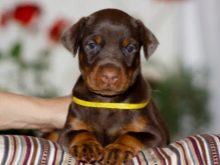

Experienced breeders are united in associations, so it is better to contact well-known nurseries that have worked well. The breeder must provide all information about the puppy, a certificate of vaccinations and passed examinations.
At the request of the buyer, the breeder must also provide medical documentation for the parents of the future pet. A good breeder pays great attention to the health and socialization of animals before they are transferred to new homes.


How to care?
Daily care for a Doberman is not complicated and does not take much time. This is a fairly large dog, however, it is often kept in apartments.
It is widely believed that smooth-haired dogs, especially those that do not have an undercoat, do not need special care. Indeed, the owners of the Doberman do not know the problems with tangling and felting. But there is another nuisance here - the loss of short hair almost all year round. Rigid bristles adhere to carpets and upholstery and are very difficult to remove.
Regular grooming can significantly reduce the problem of molting. Wool falls out when it is damaged or too dry. It must be regularly nourished - 2-3 times a week sprayed with an air conditioner containing high-quality oils, and after the bath, always apply a regenerating balm. With this care, the coat will become healthier, silky, stronger and will fall out less.
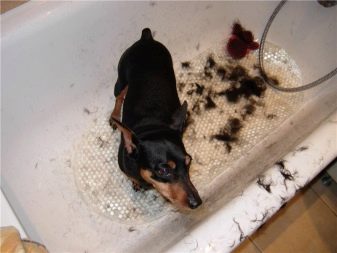
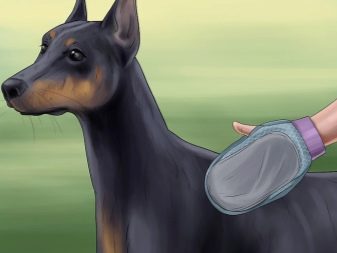
Due to molting, the dog must be combed regularly with a brush with thick bristles. A rubber brush is also very good, but only with soft tips adapted to the size of the dog. A stiff brush can damage the coat. Wire and metal brushes are not suitable for Doberman wool.
The frequency of swimming is arbitrary. Usually, a Doberman is bathed when he gets dirty, but at least 4-5 times a year. It is believed that bathing smooth-haired dogs is not necessary, but it should be remembered that not only ordinary dust settles on the wool, but also many different chemicals that dry it. Therefore, the dog must be washed, and the balm applied after rinsing creates a protective film from the aggressive effects of reagents.
For bathing use shampoos or care products that are adapted to the current needs of the coat. In case of dryness or skin problems, it will be a restorative shampoo, in case of color problems - a means to enhance color.
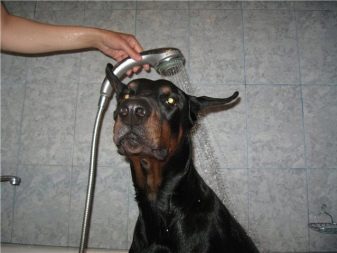
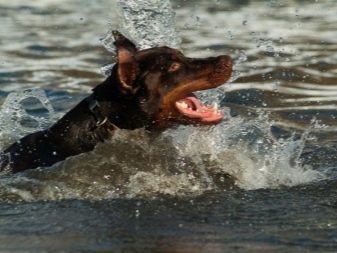
If for some reason there is no way to bathe the dog, and it got dirty, you can wipe the wool with a damp cloth dipped in water or a special lotion.
Regular grooming and cleaning also requires the eyes and ears of the pet. Due to the tendency to form tartar, you need to brush your dog’s teeth 2-3 times a week. Claws are recommended to be cut 2-3 times a month.
To prepare for the exhibition, the dog needs to be thoroughly cleaned, combed and wiped with a special conditioner to give softness and shine. Claws should be trimmed so that they do not touch the floor. This is best done a week before the show.
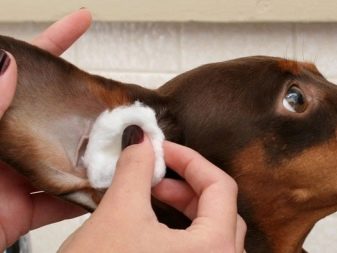
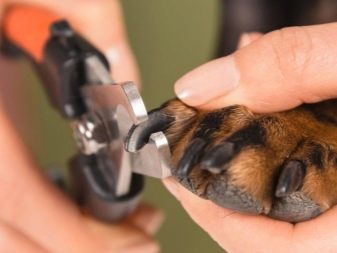
The dog at the exhibition should have a perfect figure, run elegantly and effortlessly, with his head held high. Therefore, it is worth paying attention to the proper maintenance and nutrition of the dog.
Dobermans are more suitable for maintenance in the country than in urban apartments. They need to move a lot, which for some owners can be very tiring (especially after a hard day). The fenced yard of a private house will give the Doberman enough space to run when there is no way to walk the pet.
Since the Doberman is a dog who is very devoted to his master and loves his family, he should not be left alone for long. The pet must be part of the family and participate in all family activities.
Improperly bred or isolated dogs that are not given proper attention often have bad habits that are hard to eradicate. From boredom and unfulfilled ambitions, they become nervous, anxiously run around the house or bark in response to every sound. Well-bred dogs are calm and balanced.

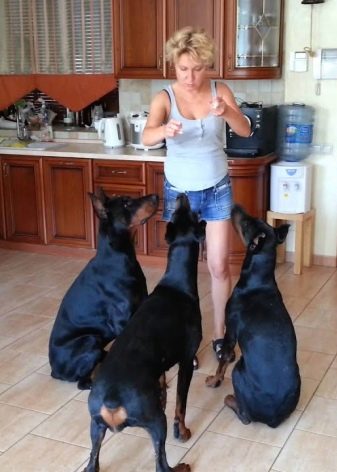
To prevent the occurrence of diseases, the dog should be taken care of and monitor the condition of its ears. However, cleaning procedures should not be performed too often. Veterinarians advise examining your ears once every two weeks to prevent possible inflammation.
The most suitable accessory for cleaning your ears is a piece of cotton wrapped around your finger.To remove dirt, you can use a special preparation to clean the ears of dogs (preparations are made on the basis of oil so that they do not harm the animal). It should be remembered that the inner part of the animal’s ear is extremely delicate and easily damaged. Therefore, cleaning must be done carefully.
Dogs with drooping ears require much more frequent monitoring. This does not mean that animals with erect ears do not suffer from diseases and inflammations of the hearing organs. Dogs with open ears are prone to scratching, irritating, and damaging the outside of the ear. They are also very vulnerable to parasite attacks.
A very serious threat to the animal is water entering the auricle. This can occur both during swimming and during the game. Each time when bathing a Doberman, you need to protect his ears, and in case of water - dry properly. When the dog dries, it usually shakes its head, which leads to a partial outflow of water into the ear canal. Water in the dog’s ears can cause infections and inflammation.

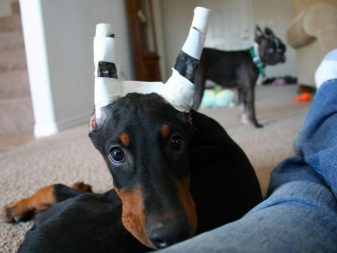
Parasites pose a great danger to the dog. When walking in the forest or when keeping in the yard with tall grass, you should be especially vigilant. There is a big risk that parasites can get into the ears of the pet, which can damage the internal organs of hearing.
Power Features
The quality of nutrition directly depends on whether the dog will be healthy and full of strength and energy or whether its existence is eclipsed by constant diseases.
Doberman can be fed with both dry food and natural products. But it is worth remembering that he has a huge appetite. An adult dog needs fresh meat, vegetables and cereals daily, in strict proportions corresponding to the age of the animal. This is a more expensive option than feeding dry dog food available at the pet store.
For economic reasons, you can think about feeding your pet ready-made dry food. This is also very convenient, since this type of food is well balanced and adapted to the various needs of the animal. The rules of feeding and dosage of portions in accordance with the age of the animal manufacturers indicate on the labels, this helps owners competently and effectively organize the feeding of the pet.

It is important to choose only premium quality feed. By purchasing such a diet for feeding Doberman, you can be sure that it will ensure the health and proper development of the dog.
Due to the risk of stomach diseases, it is worth dividing the daily portion of food into two meals. After eating, the dog should rest for at least two hours.
Dogs should have unlimited access to clean fresh water.
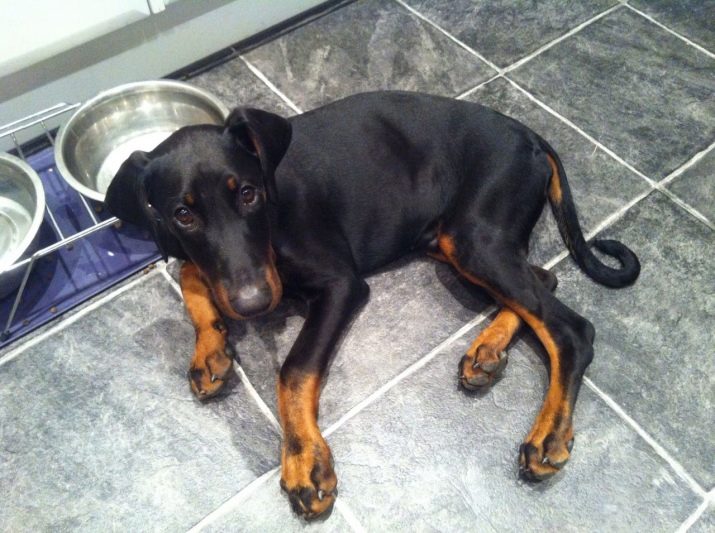
Docking ears and tail
Copying the ears and tails of a Doberman has both supporters and opponents. Below are the most commonly used arguments in favor of stopping.
- The dog looks better and more recognizable if he stops the tail and put his ears beautifully.
- Amateurs and breeders find it difficult to get used to the natural appearance of tetrapods. It is believed that the tail should be trimmed for the pet to increase the chances of winning exhibitions.
- With long tails, hunting injuries are possible.
- A dog with cropped ears and tail looks more menacing.
- Some breeders claim that when ears are cropped, dogs are less likely to catch an infection.

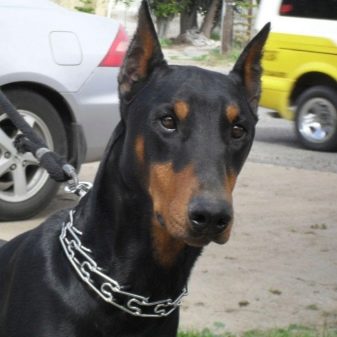
Below are the most repeated arguments of the opponents of the stop.
- The pain accompanying the relief is severe and sudden, but over time it disappears. However, there is chronic pain that the animal feels long after the wound has healed. Studies conducted on lambs, which also stop tails, showed that they feel pain for 3-4 hours after surgery.
- Scientists suspect that stopping the ears makes dogs suffer long after amputation.Studies have shown that dogs docked several years ago suffered from the pain of their docked tails. This can cause nervousness or unpredictable pet behavior.
- Stopping the ears and tails makes it difficult for the dog to properly transmit body signals. When the dog is calm, her tail is down and her ears are pressed, and vice versa: the tail and ears are raised in an excited dog, and mood is difficult to determine in cropped animals. Perhaps that is why other dogs attack them frequently. This can also provoke retaliatory aggression.
- Some owners of docked Dobermans admit that their dogs are aggressive towards their owners and family members.
- The muscles of the tail, croup and pelvic area are connected to each other. Tail relief is therefore associated with muscle dysfunction. This can cause unwanted problems in the dog, such as fecal and urinary incontinence, and perineal hernia.
- It is assumed that the muscles of the hind limbs may develop abnormally in animals in which the tail was removed in the first days of life.
- Sometimes unprofessional tail and ears stop, and improperly placed ears can ruin the appearance of a dog for life.
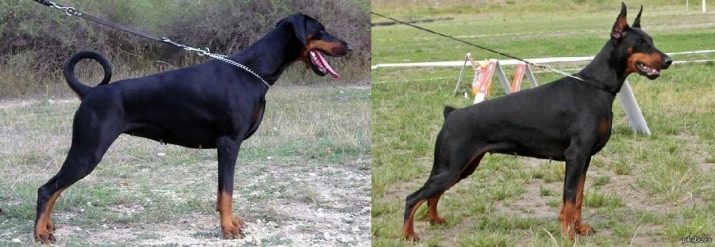
Fortunately, for reasons related to animal welfare, ear and tail mowing was banned in the 1990s. Natural ears and a long tail gave the dangerous Dobermans a softer and friendlier look.
After that, many dog breeders ceased to be interested in Doberman and breeders refused to breed. Despite this, charming Dobermans with drooping ears gained many new fans and remained a very popular breed. A strong guard dog has become a very welcome family dog.
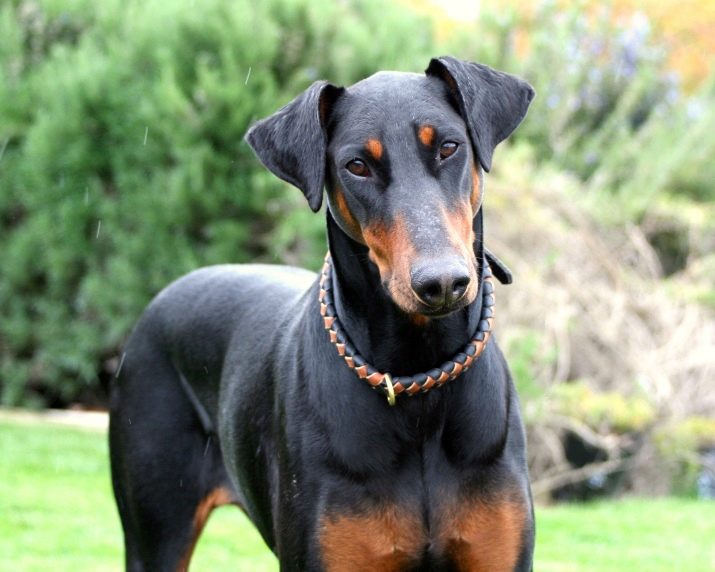
Parenting and training
Dogs of this breed are usually obedient and love to work. They easily adapt to new situations and situations, but at the same time they are ambitious and focused. Dobermans are also considered very intelligent dogs with a high level of intelligence. Those who value these qualities and try to maintain them will receive an excellent family dog.
Doberman requires a solid upbringing and socialization from an early age. Like humans, the first months of life are crucial for Dobermans. Dogs of this breed should come into contact with people and other animals as soon as possible, especially if they are later sent to families with children.
Positive experiences during puppy growth will shape the character of the dog for life. Due to his quick wit and ability to adapt, the Doberman quickly learns to recognize certain situations as normal and safe for his human family.

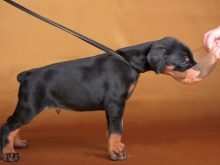
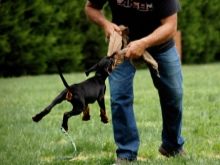
A well-mannered and socialized dog will not attack and will not bite anyone for no reason. Doberman can perfectly control his attention and aggression when he hears a command. The pet needs an experienced and reliable owner who will clearly and consistently raise and train him. When such a person once receives the trust of a Doberman, the dog will become his faithful and devoted pet for life. Doberman is a mirror image of its owner, which is much more noticeable in this breed than other dogs. Thus, the owner can be sure of a controlled and at the same time obedient companion.
Training and raising dogs of this breed requires great patience from the owner, as well as investment of time and money. But all this is worth it, since professional education, a sufficient amount of movement, creative games and fascinating tasks are the basis of a harmonious life of a dog and a person.

Suitable nicknames
When choosing a name for a dog, it is worth considering the individual characteristics of the pet: breed, size, character and temperament. You can give the dog a simple nickname, more popular or reward the pet with an exotic name.
Here are some sample nicknames for boys:
- Sparky;
- Sheldon
- Brutus
- Teddy;
- Mike;
- Grow;
- Jake;
- Jazz;
- Archie;
- Rex
- Rhine
- Balto
- Rocky
- Hermann;
- Scooby
- Leader;
- Onyx.
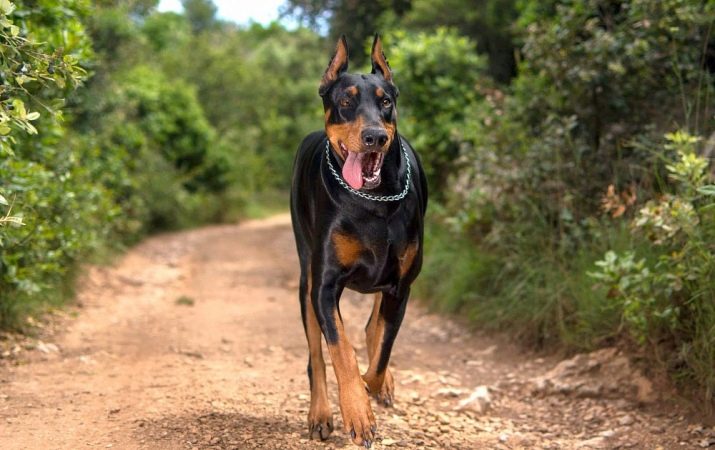
You can choose a nickname for girls from this list:
- Belle
- Tiana
- Rihanna
- Selena;
- Amy;
- Ashley
- Jessica;
- Adele;
- Buffy
- Gerda;
- Xena
- Moon;
- Lady;
- Roxy;
- Skoda
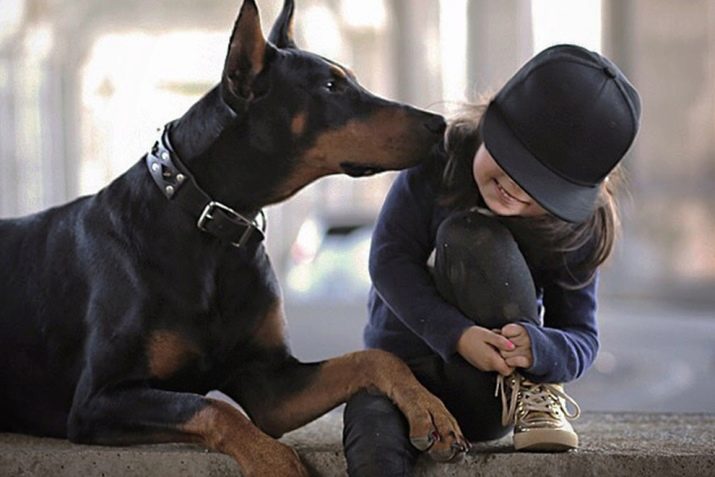
Owner reviews
According to most owners, Dobermans are the most beautiful and wise pets. Someone believes that these dogs can be safely left at home with children. But most owners are inclined to believe that this is still not worth it. It is difficult to predict the behavior of a dog without the presence of a host nearby. In addition, children may not know how to behave properly with a Doberman and can provoke a dog to aggressive behavior.
Dogs are very attached to their master and remain faithful to him for life. These dogs have a hard time parting with their owner. This can cause adult dog anger, uncontrollable and aggressive behavior.
Doberman is one of the most elegant breeds in the world: an athletic, muscular body in harmony with the high intelligence of the dog.
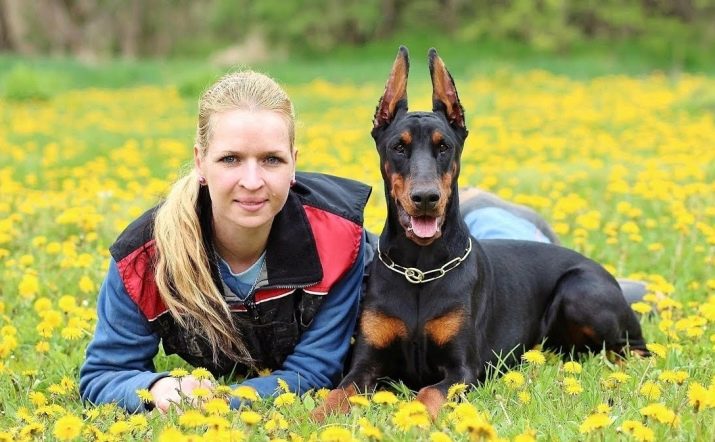
This dog is a real pride for its owner. But it requires considerable effort in training and education. She needs a lot of training, movement in the fresh air. It is the perfect companion for sports people.
Dobermans love fun and outdoor games with their families. Sometimes this can be inconvenient, especially when keeping the animal in the apartment. Therefore, dogs need to pay a lot of attention, affection and love.
Dobermans are very sensitive to the mood of the owner and try to cheer him up as soon as possible if they see that the owner is sad. These are faithful and loving pets. They are infinitely loyal to their family and are ready to protect it from any threats. At the same time, they do not trust strangers and may be aggressive towards them.
Except for intensive training and the difficulties of education, Dobermans are not whimsical in care and maintenance. But they have a tendency to damage property, eating things in the house and restless behavior, so the dog needs proper and timely education.
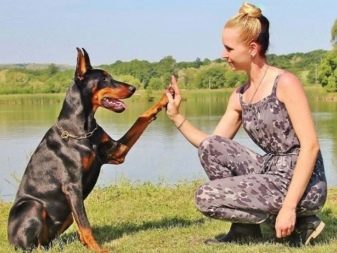
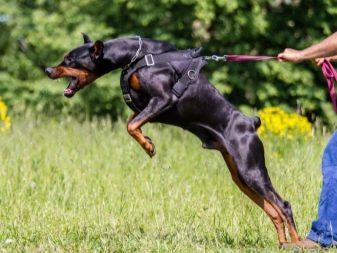
Doberman is best suited to keep in a private house with a fenced area than in an apartment. But even in city apartments they are willingly turned on. In this case, you need to provide the pet with a sufficient level of mobility and often walk with him in the fresh air.
Although Dobermans have a reputation for fierce defenders and furious guards, with proper education they can be very gentle and affectionate. But only with members of his family. Thanks to watchdog qualities, courage and strength dogs of this breed are ideal for police and guard, but on condition that one person will work with them, since the Doberman does not recognize several owners.
A full description of the Doberman breed in the next video.
